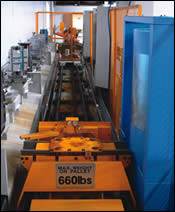From Job Shop Chaos To Lean Order
Classic lean manufacturing principles are practically taken as gospel, but benefits can be elusive for manufacturers that produce a variety of parts in low volumes. This shop took a different approach to lean—one aided by software that helped identify a more efficient machine layout based patterns in part routings.
Jeff Gleich was frustrated. The year was 2007, and Mr. Gleich had done everything he thought he was supposed to do to implement lean manufacturing principles two years after coming back onboard at The G&G Manufacturing Company, a job shop founded by his grandfather, Kurt Gleich. A Kaizen program was well underway, setup teams had been put in place to improve spindle uptime, and 5S and other lean programs had helped identify and reduce waste. Nonetheless, the shop had hit a wall when it came to continuing the efficiency gains realized at the start of its lean journey. “It seemed like we’d taken a step forward only to take another step back,” Mr. Gleich recalls.
Getting out of the slump required two key insights about the nature of lean manufacturing and how it applies to the job shop, as opposed to production environments (Toyota is the classic example). First was the understanding that the vast majority of generally accepted lean practices are designed to optimize flow—that is, how product is routed through the manufacturing operation. Second, and most critical, was the realization that the most effective way to streamline flow in a high-mix, low-volume operation is to organize jobs into process families rather than part families.
Armed with these notions and a software analysis tool that helped identify patterns in job routings, G&G realized improvements in productivity and lead time ranging to 25 and 50 percent, respectively. Of course, implementing what Mr. Gleich calls “flexible flow cells” and other strategies associated with this idea of lean was easier said than done. Likewise, the insights described above certainly didn’t spring from his brain unprompted. The following offers a glimpse into the evolution of G&G’s lean thinking, the challenges it faced, and the software that propelled its transformation into an exemplary model of how lean can be adapted to a job shop environment.
The Journey of a Thousand Miles…
…begins with a single step, as the saying goes, and G&G has come a long way since its first tentative steps toward lean implementation in 1998. That year, a top-tier customer introduced Mr. Gleich’s father, Kurt Gleich II, the company’s owner and president at the time, to a book called “Lean Thinking” by James T. Womack and Daniel T. Jones. It was essentially a demand to “get lean or else.” “Dad dropped the book on my lap and said, ‘I need you to read this and figure out how we can get this done!’” Mr. Gleich recalls.
After reading the book, Mr. Gleich put together some training material and set out to start the shop’s lean journey. G&G moved away from departmentalizing machines and other equipment by type and toward its first cellular layouts. The shop realized some benefits, but ultimately, its commitment to lean faltered. The new cells, which were organized to complete specific jobs as efficiently as possible, lacked the flexibility required to accommodate inevitable changes in demand and in the shop’s product mix. If a contract wasn’t renewed, the cell became useless and would be broken up.
The Job Shop Difference
These initial efforts with cellular production illustrate the difficulty of applying a “one-size-fits-all” approach to lean practices. A high-mix, low-volume operation like G&G isn’t exactly what Toyota engineers had in mind when they developed their famous production system in the wake of World War II to streamline the production of automobiles. Rather, the Toyota Production System (TPS), which forms the basis for much of today’s lean thinking, is geared toward large assembly plants dedicated to high-production processing of a relatively limited number of parts or part families. In contrast, a typical job shop tries to be “all things to all people,” Mr. Gleich says.
That’s somewhat true of G&G, which serves a wide variety of industries with all manner of part sizes and shapes from its 30,000-square-foot facility in Cincinnati, Ohio. Materials machined here include steel and stainless steel; harder alloys such as titanium and Inconel; and copper, bronze and plastic, to name a few. In addition to an array of mills, lathes, machining centers and screw machines, the shop floor is home to equipment used for secondary processes such as grinding, lapping and honing. The company produces approximately 1,000 different parts in batch sizes ranging from the hundreds to the thousands for more than 120 regular customers.
Pursuing such a dynamic mix of jobs presents a number of lean implementation hurdles that would be completely foreign to a large, assembly-type operation. Many parts share relatively few machining resources. Design changes are common, demand fluctuates, and contracts can change from year to year. Delivery dates, lot sizes, equipment requirements and cycle times are also highly variable. As a result of these and other factors, dedicated cells, “pull” production based on Kanban visual aids and other practices designed for continuous flow simply don’t translate easily to this environment.
As such, it’s no wonder so many job shops have floundered in their attempts at lean. This is not to say that the central philosophy of lean—improving efficiency by doing away with all processes or practices that don’t add value for the customer—doesn’t apply to the job shop. Rather, the issue is a lack of well-defined methods for implementing that philosophy in a high-mix, low-volume operation.
Mapping Job Shop DNA
Dr. Shahrukh Irani, associate professor at The Ohio State University’s Department of Integrated Systems Engineering, has been attempting to change that. One recent project in his job shop lean research was the development of the Production Flow Analysis and Simplification Toolkit (PFAST). PFAST is a library of software programs designed to evaluate and simplify material flows in order to help manufacturers develop part families and machine groupings.
In a job shop, it might appear that no two parts are alike in terms of how they proceed through the process chain. However, in the end, all move through a relatively limited number of work stations. PFAST helps identify common patterns in these routings. Paired with data regarding the frequency of a job, its volume and the revenue it generates, these patterns help manufacturers design efficient shop layouts that facilitate optimum flow and prioritize the most important work.
Mr. Gleich credits this software tool for helping G&G overcome a key hurdle in its lean journey. However, he never would have met Dr. Irani or discovered PFAST if he hadn’t come to a key realization about why the shop needed such a tool. That is, when boiled down to its essence, lean is really all about flow. If a job shop were a living organism, part routings would be its DNA—the genetic blueprint for how it functions. Addressing operations on this basic level is imperative to changing a shop’s essential makeup and getting the most out of lean. Without optimizing routings, a shop can go only so far with alternative efficiency-boosting strategies, useful as they may be.
Reaching an Epiphany
Of course, Mr. Gleich came to this realization the hard way. By the time he met Dr. Irani at OSU’s annual Job Shop Lean Conference in November 2007, the shop had pursued lean on and off for about a decade. After failures with cellular layouts in the ’90s, those efforts began again in earnest in 2005, when Mr. Gleich returned to his family’s business to spearhead lean efforts after working as a dot-com entrepreneur.
A year later, the company hired outside consultant Definity Partners to assist with implementing a comprehensive Kaizen system. For the first time, it began to track and review metrics critical to making and understanding the impact of changes. Setup reduction programs and 5S organization further contributed to efficiency. At first, all this paid off—big time. “My mandate was ‘10 years in 2.’ We needed to make up for 10 years of faltering at lean that fast to stay relevant,” Mr. Gleich notes. During that time period, productivity increased 20 percent, lead times were cut by 40 percent and scrap and rework were halved.
However, by the fall of 2007, the shop had essentially reached a plateau. After these significant initial gains, productivity had inched up by only about 2 percent. As mentioned above, it all came back to flow. Tracking metrics and streamlining processes did little to alleviate inconsistencies and bottlenecks resulting from the fact that workloads on the shop’s machines, each of which is responsible for a variety of jobs, tended to change with demand.
Mr. Gleich recalls staring at the schedule board, thinking there had to be some simple, common denominator underlying all the shop’s work that would provide a basis for more efficient part routings. He was suddenly struck by the notion that perhaps the business wasn’t so complicated and unpredictable after all. In fact, the entire operation could be boiled down to about 8 core process flows that involved various sequences of milling, turning and the like. Rather than organizing thousands of different jobs into thousands of part families, wouldn’t it be more efficient to organize work according to the comparatively few machining processes required to produce it?
Mr. Gleich thought so. But even after entering the routings for about 100 parts into an Excel spreadsheet—a time-consuming endeavor, to say the least—he had difficulty determining the best way to organize the machines on the shop floor. While he had gained a better understanding of the varying workloads on each machine and how parts flow between machines, identifying similarities among so many different routings seemed an insurmountable task.
Decrypting the Product Mix
That was in August 2007, three months before Mr. Gleich attended the OSU job shop lean conference where he would meet Dr. Irani, a moderator at the three-day event. Afterwards, Mr. Gleich was convinced that he was on the right track with his idea of process families. “Dr. Irani’s presentation crystallized everything in my mind, and we really hit it off.”
The relationship paid dividends. By February of 2008, Dr. Irani had visited G&G multiple times to evaluate the operation and conduct lean seminars. By spring, the shop had implemented PFAST and begun the process of organizing its machines into hybrid flow cells to ensure efficient routing of its diverse parts. PFAST helps prioritize the most important jobs, segments those parts into process families and outputs a series of reports that aid in developing an efficient shopfloor layout. The first step is to input the necessary data, including each part’s number, routing sequence, annual production quantity and annual revenue.
In a case like G&G’s involving large numbers of different jobs, PFAST analyzes a representative sample of parts that prioritizes the most important work, as opposed to the entire mix. To aid in selecting such a sample, the software segments the part mix via a process known as PQ$ Analysis, where “P” represents the part, “Q” represents annual production quantity and “$” represents annual revenue. Each part is displayed in its appropriate position on a scatter plot, with quantity plotted along the X axis and revenue plotted along the Y. Dividing the plot into four quadrants reveals which parts are high quantity/high revenue, which are low quantity/high revenue, and so on. Each grouping merits a different layout and manufacturing strategy.
Then, PFAST uses a series of algorithms to compare the routing sequences of each part within the sample. The software groups clusters of parts that share similar routings into potential process families that could be produced more efficiently by co-locating certain machines or workstations together in a cellular configuration. Reports PFAST generates from this analysis suggest whether a shop would be best served by a traditional cellular or hybrid cellular layout (more on that below). If there is significant overlap among the potential cells, and if that overlap involves expensive machines that must be shared between them, hybrid cells are likely the best choice. This is typically the case for high-mix, low-volume job shops, as it was for G&G.
Focusing on Value
Nonetheless, some jobs at G&G do occur with enough frequency to merit production in a traditional, U-shaped cell. For example, one such cell, shown on page 63, is dedicated to production of a forged, silicate iron component for the rail industry. Parts like this, which typically involve 35 weeks per year or more of production time, are classified as “runners.”
However, runners are rare at G&G. Jobs at the other end of the spectrum, known as “strangers,” are characterized by erratic, unpredictable demand and are ill-suited for extensive efficiency boosting efforts. The backbone of the shop’s work—and the primary focus of its lean efforts—are “repeaters,” jobs for which demand is somewhat regular but not sufficiently periodic to justify dedicated cells.
As such, repeaters made up the majority of the part sample G&G selected with the aid of PQ$ Analysis. The shop’s hybrid cells, organized around the most frequent part routings within the sample, standardize the process for producing these jobs. The fact that G&G emphasized improving the process for repeaters illustrates a key point: The sample selected for PFAST analysis should consist of parts that represent the highest value for the shop. Any layout change should be geared toward streamlining production of parts that generate the most profit. “Sometimes, lean practices can force you to do all the right things around all the wrong stuff,” Mr. Gleich says. “It’s not just about lean, it’s about running a business and providing a compelling offer for the market.”
On the surface, basing facility layout on only a portion of the total product mix might seem counterintuitive. Wouldn’t comparing routings for all parts result in a more efficient layout overall? What this logic fails to take into account is the fact that the selected sample of high-value jobs typically represents a disproportionate share of both total production volume and total revenue. That was certainly the case at G&G. Moreover, products not included in the sample might have similar or identical routings to their higher-priority cousins.
A Different Kind of Cell
The end result of G&G’s efforts to streamline flow was the implementation of hybrid cellular layouts. This arrangement combines the flexibility of a process layout, in which machines of similar types are grouped together, with the low throughput times and work-in-process levels of dedicated cellular layouts. The idea is to realize the advantages of producing part families identified by PFAST in cells while also maintaining flexibility by keeping shared machine types close to one another. G&G’s operation contains six of these flexible cells, each arranged for a separate process family identified by PFAST.
One such cell used for G&G’s higher-value, medium- and large-sized turning and milling work is perhaps the best example. The most obvious difference between this cell and its more-common, dedicated brethren is that the cell isn’t shaped like a “U.” Rather, it consists of two parallel lines of machines, each containing identical equipment (in all, the cell contains two opposing VMCs and two opposing lathes, and the process family shares a single HMC). Rather than being bunched together, as is the case in most dedicated cells, the machines are spaced far enough apart to allow parts to flow in and out at various points.
The logic behind this design is to avoid the set “in” and “out” points common to most cells. This enables streamlined production of various parts that share similar—but not necessarily identical—routings. For example, one part might flow from the lathe to the mill, while another might flow from the mill to the lathe. If one of those machines is occupied, the part can be processed on the identical machine on the opposing side of the cell. Enabling work to enter the cell at any point, flow down one side or the other and cross the aisle as-needed helps ensure timely, efficient production of a variety of parts with only one thing in common: the processes used to produce them.
Another example is shown in the picture on page 62, which depicts a cell for smaller turn and mill work. This cell consists of two bar-fed lathes on either end with one milling machine and one chucking lathe in the middle. Similarly to the “mirror” cell described above, work can enter and exit from either side, and a variety of mini cells can be created on demand. Having multiple types of the same kinds of machines helps ensure that other options are available if one machine is occupied. “Whether we’re turning or milling, it’s set up to flow parts between each machine in the area with a minimal amount of work stoppage,” Mr. Gleich says.
Quoting Intelligently
Organizing hybrid cells around process families based on similarities in part routings has led to lead time improvements ranging from 40 to 50 percent and productivity improvements ranging from 20 to 25 percent, depending on the job. However, G&G’s lean reorganization has led to more intangible benefits, as well. A prime example is the fact that the shop has greater assurance that it can produce incoming work just as efficiently as long-standing jobs.
That’s because G&G’s hybrid cells are sufficiently flexible to produce a wide range of parts, as evidenced by the benefits already realized on current and past work. Considering the limited number of machining operations around which these cells are based, any new job will likely fit into an existing process family. With this in mind, the company has endeavored to teach its sales force how to evaluate potential jobs in light of the lean system it’s implemented. In addition to helping develop an appropriate quote, this can keep the cells fed with work that is likely to be the right cost for the customer and the right profit margin for G&G, even when demand for jobs in certain process families drops off.
Of course, this also ensures that the shop sticks to work it feels it can produce at a competitive advantage while still providing the flexibility to pursue a diverse mix of jobs. “The more work we find that we can successfully produce on these cells, the better,” Mr. Gleich says. “Know thyself! It’s just as important to be good at ‘no’ quoting and rejecting jobs that don’t fit—it keeps us focused on what we do best.”
Related Content
6 Tips for Training on a Swiss-Type Lathe
There are nuances to training a person to effectively operate a Swiss-type lathe. Derek Korn, Production Machining’s editor in chief, shares suggestions from a CNC machine shop.
Read MoreIn Moldmaking, Mantle Process Addresses Lead Time and Talent Pool
A new process delivered through what looks like a standard machining center promises to streamline machining of injection mold cores and cavities and even answer the declining availability of toolmakers.
Read MoreWhen Handing Down the Family Machine Shop is as Complex as a Swiss-Turned Part
The transition into Swiss-type machining at Deking Screw Products required more than just a shift in production operations. It required a new mindset and a new way of running the family-owned business. Hardest of all, it required that one generation let go, and allow a new one to step in.
Read More8 Ways to Increase Productivity on the Manufacturing Floor
When it comes to machine shop productivity, continuous improvement depends on efficient employees, equipment and processes.
Read MoreRead Next
Cells To The Max
Brad Hart, president of Roberts Tool Company, in Chatsworth, California, believes that automated cells are the key to survival for companies likes his that machine complex, high-precision parts for aerospace and defense. Cellular manufacturing makes it possible to reduce lead times dramatically and minimize labor input while increasing throughput and improving quality, he says. In his shop, a cell consisting of two Toyoda HMCs and a dozen pallet stations epitomizes the lean manufacturing concepts that Mr. Hart finds so compelling. However, he says that shop owners have to get out of the business of making parts and into the business of building processes--processes such as those embodied in a lean manufacturing cell.
Read MoreLean Manufacturing Shapes A Cell
A machining cell that seeks to optimize product flow may look very different from a cell that seeks to optimize a machining process.
Read MoreLean Manufacturing For The Job Shop
Lean practices are not just for predictable production. Here are the common-sense ways this low-volume job shop has implemented a leaner process.
Read More





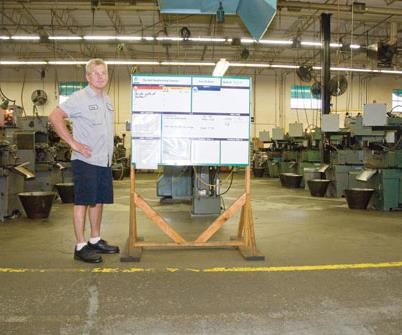
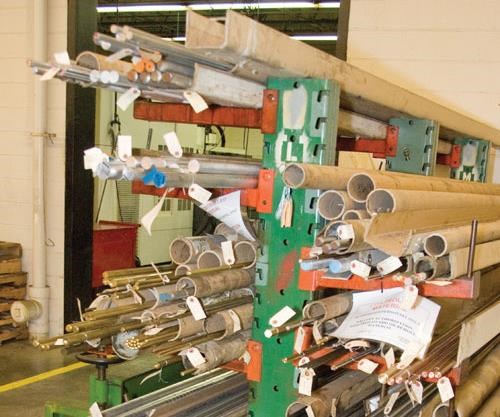
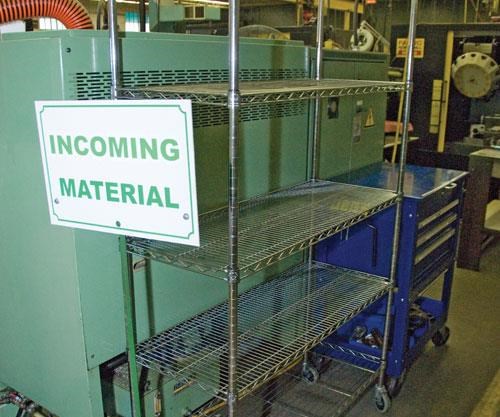
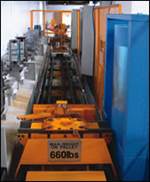

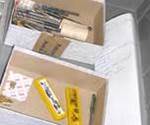










.png;maxWidth=300;quality=90)












